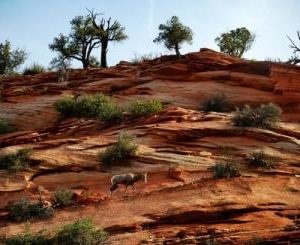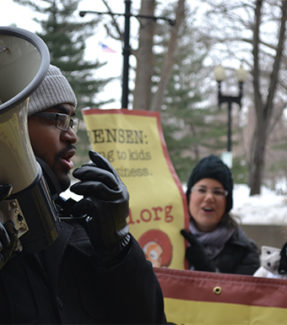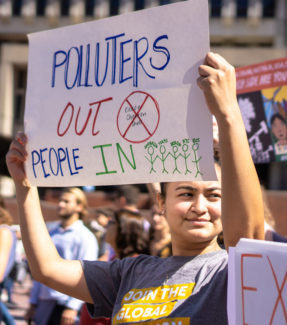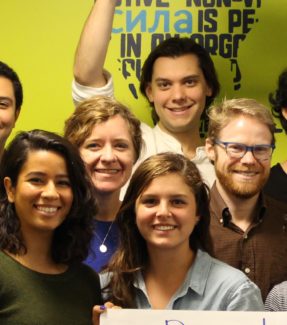By Darryl Fears, The Washington Post.
The Trump administration has ended a six-year-old ban on selling bottled water at some national parks that was aimed at easing plastic pollution and the huge amount of waste being recycled.
In a statement that closely tracked the arguments of a campaign by the International Bottled Water Association (IBWA) in opposition to the ban, the National Park Service said the 2011 action under the Obama administration “removed the healthiest beverage choice at a variety of parks while still allowing sales of bottled sweetened drinks.”
The move follows a review of the policy “in close consultation with Department of Interior leadership,” according to the statement Wednesday. The department declined to elaborate.
The decision came three weeks after the Senate confirmation of David Bernhardt as deputy interior secretary. Bernhardt is a former lobbyist with the law firm Brownstein Hyatt Farber Schreck, which has represented one of the largest water bottlers in the United States, Nestlé Waters. Nestlé distributes the Deer Park brand.
Some Democratic senators called Bernhardt a “walking conflict of interest” during his confirmation hearing, because of his work on behalf of corporate interests opposed to Interior Department regulations to promote clean air and water.
“Under Trump, the Department of the Interior appears to be working hand in hand with the bottled-water industry to do its bidding,” said Lauren DeRusha Florez, associate campaign director for Corporate Accountability International, a nonprofit groups that takes on the tobacco, fast-food and fossil-fuel industries.
The industry association hailed the decision as recognizing “the importance of making safe, healthy, convenient bottled water available to the millions of people from around the world who want to stay well hydrated while visiting national parks,” said IBWA spokeswoman Jill Culora. “Consumption of water in all forms — tap, filtered and bottled — should always be encouraged.”
In its numerous arguments against the ban, the association commonly referenced the health of visitors but rarely mentioned another key consideration: profits. The Park Service’s 411 sites draw more than 300 million visitors annually.
A recent study showed that of the more than 9 billion tons of plastic produced since 1950, the vast majority is still around. Yet only 2 billion tons are actually still being used, according to the study.
The rest is stuck as garbage in landfills and as pollution littering the land and deep oceans, where it has been discovered in the mouths of whales and the bellies of dead seabirds that mistook it for food. A small amount is eliminated in incinerators, which can produce harmful emissions, the study said. Recycling plastic bottles only delays their eventual trip to a trash container.
“National parks, as premier tourist destinations, use taxpayer dollars to manage the burden of discarded plastic water bottles,” said an earlier memorandum by the Park Service’s facility management division. “Notably, this is a relatively new financial burden, with global sales of bottled water quadrupling between 1990 and 2005.”
The memo said the division’s decision was based on “the 50 billion plastic water bottles” disposed of by Americans each year and the “approximately 20 billion barrels of oil” required during production — when millions of tons of greenhouse-gas pollution are generated that contribute to global warming.
To offset the sudden elimination of water bottles for thirsty visitors, the Park Service spent millions of dollars to install water stations. Only 18 parks had instituted the ban, but its effect over time stood to be far more significant once they all became involved.
Grand Canyon National Park estimated several years ago that water bottles constituted 30 percent of the 900 tons of garbage it recycled. Zion National Park estimated that its sale of reusable bottles that visitors took home skyrocketed by 78 percent once it banned bottled-water sales.
The water industry fought back, challenging the Park Service’s rationale for banning bottled-water while still allowing sugary drinks. Asked Thursday whether the IBWA had analyzed the ratio of bottled-water consumption compared with soda and water consumption at parks, Culora said the association did not have such data.
But the lobby pointed out that visitors were still allowed to carry bottled water into parks, as well as food items wrapped in plastic. Its analysts argued that the Park Service could not back claims that the ban had eliminated massive amounts of waste, and some members of Congress were persuaded. Last year, lawmakers called on the agency to produce a comprehensive assessment of the ban’s effect.
That assessment was completed, a person with knowledge of the report said, but not publicly released. The Interior Department did not respond to a request for comment.
Zion National Park stood by its program in a recent report, saying it “encourages visitors to drink from reusable water bottles.” The water filling stations “also serve as exhibits, giving visitors information about the impact of disposable bottles, as well as the safety and purity of Zion’s water and the importance of staying hydrated, especially in the desert. The end results are avoided waste and a learning opportunity for visitors.” In addition, it resulted in “the equivalent of 5,000 pounds of plastic not entering the waste stream,” the report said.
In the Park Service statement Wednesday, acting director Michael Reynolds said the parks will offer bottled water and the water stations to serve visitors. “Ultimately it should be up to our visitors to decide how best to keep themselves and their families hydrated.” he said.
The statement did not address the environmental impact of discarded plastic bottles at parks.
Florez said the Interior Department wasted an opportunity to improve the environment on the millions of acres that parks occupy. “If you need evidence of that chilling effect, look no further than the fact that 200 parks have privately expressed an interest in going bottled-water-free or have already taken steps to do so,” she said.
###




